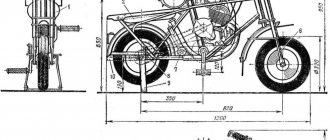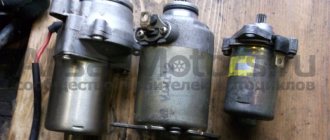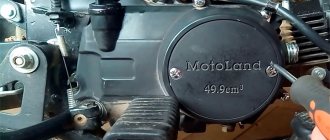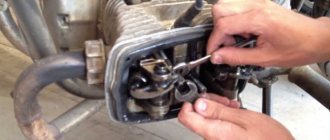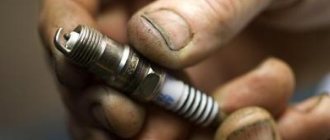Very often on various forums people ask questions like “Why does my moped stall and won’t start?”, and often receive a bunch of advice on what needs to be replaced, even advice to change the moped to a “cooler” one. In fact, even a technically untrained person can diagnose the main engine malfunctions. Let's sort it out in order.
So, for stable operation of the engine, three conditions are needed:
- A good spark on the spark plug electrodes, at the right moment.
- The presence of the “correct” working mixture in the combustion chamber.
- The presence of “compression”, that is, a working cylinder-piston pair and properly functioning valves.
You don't need to be an experienced mechanic or have a bunch of expensive tools to diagnose your moped. Let's look at simple methods for finding a fault.
Visual inspection
You should always check using the “from simple to complex” . If the moped was working like a clock just yesterday, but today it refuses to start, remember what happened to it during this period of time. Maybe you made changes to the electrical circuit, or adjusted the carburetor, or washed the moped, or did some other work - sometimes this helps to localize the fault. If possible, return everything back.
Before starting the test, carefully inspect the moped. You may notice a torn or exposed wire or some other small thing. Sometimes this helps a lot.
Checking the presence of a spark and the condition of the spark plug
This is the simplest check that every moped owner can carry out, having only a spark plug wrench or a spare spark plug on hand. Moreover, if you unscrew the spark plug from the engine, you can at the same time assess its condition and understand by the color of the carbon deposits how correct the working mixture is being prepared by the carburetor.
So, if you unscrew the spark plug from the engine, pay attention to the carbon deposits that cover the central electrode. The carbon deposits should be brown or light brown in color. If the carbon deposits are black, this indicates that the mixture is too rich, or the spark plug is faulty, or the engine is “eating” oil. Perhaps this is the reason for poor engine performance.
Also pay attention to the presence of liquid on the candle. If the spark plug is “wet”, that is, there is gasoline on the spark plug, then gasoline still enters the combustion chamber, but does not ignite. There are at least three reasons why a spark plug may be wet:
- trying to start the engine with the ignition turned off - if you turn the engine with the kick starter for a long time, the spark plug will simply flood with fuel and it will not be able to work normally. To solve the problem, the candle needs to be dried, for example, heated with a lighter.
- The spark plug is faulty - if the spark plug insulation is broken or the gap is broken, the spark plug will not work normally. Only replacing the spark plug with a known good one will help here.
- ignition system faulty
Now we put the tip on the spark plug and press it to a metal surface, for example, to the engine head, turn on the ignition and turn the engine with the kickstarter. It is more convenient to check the spark together, so that one person holds the spark plug and the other turns the engine. But in principle, one person can handle it. Be careful - there is high voltage at the center electrode of the spark plug.
If there is no spark, then the ignition system is at fault. Check all wires for breaks or shorts to ground. All electrical wiring connectors must be connected. If possible, replace the ignition coil with a known good one. Check if the generator coils are damaged. You can read more in the article “The moped has lost its spark, what should I do?”
If you can’t figure out the wiring, contact someone who knows how to do it.
If there is a spark, then most likely the problem is in the power system. Screw the candle into place and continue.
Reasons why the scooter does not start when cold
:is::is::is::is: killed. I won’t say anything further. I’ll just ask a question - uncle, how old are you? and then what the HELL they say to check the compression not hot, not cold! and then when the engine is slightly warmed up. - I’ll answer.
It’s nice when the engine of a four-stroke scooter works “like a clock” and does not cause any trouble to its owner. But basically this only happens when the unit is warm. As soon as the two-wheeled “minibike” sits in the cold for a while, that’s it – there’s no way to start it when it’s cold. And you can't make it purr either from the starter or using the foot. So why does it happen that a four-stroke scooter does not start? The most common problems are in the ignition and fuel supply systems. More on this below.
Diagnosing a candle
The first step is to conduct a visual inspection of the spark plug. Unscrew it and look carefully to see if there are any mechanical damages or defects associated with melting. If any of this is present, then the spark plug should be replaced. In addition, moisture could get on it. To verify this, you need to remove the ignition element from the cap and let it dry. You can even do this over a gas one.
Quite often you can see cases when the owner is faced with the following problem: the scooter will not start. This may be due to a large number of reasons. Most often these are typical breakdowns or malfunctions, especially if the moped was parked in cold weather. Depending on the identified problem, the moped can be repaired in a few minutes or several hours.
Typical reasons
First of all, you need to check: the ignition and power systems. Carry out a check in those places that can cause the moped to move. The reasons why the scooter does not start, especially in cold weather, may be the following:
No spark in spark plug
The scooter does not start because there is no spark in the spark plug. In this case, you need to do the following: the spark plug is unscrewed and checked for suitability. Connects to the ignition coil using a wire.
Checking the engine power system
First of all, you need to make sure that there is enough gasoline in the gas tank. There is a small tube inside the gas tank that takes gasoline not from the bottom of the gas tank, but a little higher. Therefore, it may turn out that there is still gasoline in the tank, but it does not flow into the carburetor. Therefore, if possible, add gasoline to at least half the tank and try to start the moped again. Perhaps this is the reason.
You also need to know that the gas tap of the Alpha moped has two positions: in one, it takes gasoline closer to the bottom of the gas tank, and in the other, a little higher. If you don’t know in which position the gas tap is open, try installing it in a different position, maybe this will help.
It is very convenient to check the gasoline supply if you have a transparent tube from the gas tank to the carburetor, or have a replaceable gas filter installed. In this case, you can immediately see whether there is gasoline or not.
There is also another simple check of the power system: take a small amount (5-10 ml) of gasoline into a syringe, remove the air intake tube from the carburetor and pour gasoline directly into the carburetor. If after this the moped starts up, or as they say “catch,” then the reason is definitely in the gasoline supply and you need to check the fuel supply and carburetor.
If after all the described checks the problem is not found, there is one more check left - checking the engine compression.
Troubleshooting
What to do if the hoverboard does not charge? Here are some simple tips for troubleshooting:
- First, disassemble the hoverboard.
To remove the bottom panel, use a screwdriver or screwdriver with the appropriate bit. This will allow you to get to the inside of the vehicle and try to find the problem of poor charging.
The side of the scooter with the charging port is the area you need to work on. Be careful during disassembly. Do not lose screws or washers, or use a drill to remove screws or bolts that will not come loose. There will be several wires directly on the inside of the plastic cover you just unscrewed.
They are responsible for charging the hoverboard: they connect the charger ports and the lithium-ion battery. The other wire line goes to the motherboard. You can temporarily disconnect it to avoid an unexpected power surge (only if the board is disconnected by a connector). If the wires are soldered, it is better not to touch them.
Is there blackening of the wire or oxidation of the contacts, is there a large amount of dust present? This may well be the reason for the device to not work correctly. Accumulations of dust must be removed, damaged wires must be replaced, and contacts must be cleaned to a metallic shine.
Having completed such an impromptu diagnosis, screw the cover back to the hoverboard, tightening all the removed bolts one by one.
They will help you make diagnostics more efficiently and without risk to the scooter. True, it is no longer free.
If, despite all this, your scooter continues to work incorrectly, you will need to contact the manufacturer and request repair instructions. In the worst case, the hoverboard will have to be sent back to the manufacturer under warranty. It may be that the device was initially faulty and will be replaced under warranty. It often happens that a newly purchased hoverboard does not charge.
We measure compression
Compression is the pressure in the cylinder at the end of the compression stroke. The magnitude of this pressure allows you to assess the condition of the engine. A working Alpha moped engine should have a compression of at least 8-10 kg/cm² (“atmospheres”) . If it is less, then the engine is faulty: either the piston rings are worn out or the valves are leaking. Most likely the engine will need to be disassembled.
Compression is measured using a compression meter - a special pressure gauge that is inserted or screwed in (depending on the design) instead of the spark plug.
Before measuring compression, it is advisable to warm up the engine, but if it does not start, you will have to measure it cold. It is also advisable to unscrew the carburetor or open the throttle valve and turn off the fuel supply.
The engine must be rotated using an electric starter or kickstarter until the compression meter readings stop increasing.
When the compression is less than 8 atmospheres , you need to pour 10-15 ml of engine oil into the spark plug hole using a syringe. If after this the compression increases noticeably, it means the piston rings are worn out . If not, then the problem is in the valves or camshaft drive . The most common reason: the camshaft drive chain is broken or has slipped, or the valves are bent/broken.
Checking the ignition timing
If there is a spark, fuel is supplied, compression is fine, but the moped still does not start - the ignition timing may be off.
On 139fmb engines, which are installed on alpha, the ignition timing is not adjustable. It is rigidly determined by the position of the flywheel on the crankshaft. The engine crankshaft on the generator side has a conical surface on which the flywheel (also known as the generator rotor) is tightly seated. The correct position of the flywheel is set using a key that is inserted into the crankshaft keyway.
You can check this visually (remove the generator cover, unscrew the nut securing the flywheel and see if the grooves match). But the groove on the crankshaft cannot always be seen (depending on the specific instance), so there is a more reliable way: buy or borrow a strobe light from someone (many car repair shops have one), unscrew the plug on the generator cover and check that flashes occur at the same time the label || appears in the window.
If the moped is not
Sometimes it happens that the moped does not want to start after several hours of inactivity. However, after warming up, it works and starts stably. Let's figure out why this happens.
When the engine is cold, all clearances (in the piston, in the valves, etc.) are far from ideal. Plus, when fuel gets on cold engine parts, it evaporates worse and therefore ignites worse. Because of this, during a cold start the engine needs a richer mixture than usual. It is for this purpose that devices are made on carburetor engines to enrich the mixture at start-up.
On the Alpha moped (and similar ones), an air damper is installed. It reduces the air flow and thereby enriches the working mixture. The damper has two positions: “closed” - the lever is raised up, “open” - the lever is lowered down. When starting “on a cold” air damper must be closed (lift the lever up) . When the engine runs for a while with the throttle closed, it needs to be opened. Driving with the throttle closed will lead to increased fuel consumption and the formation of carbon deposits on the spark plug and piston.
What to do if a cold moped does not start even with the throttle closed? Try using a syringe to fill in 5-7 ml. gasoline directly into the carburetor inlet pipe. If the moped starts after this, then the carburetor needs to be adjusted. If it doesn’t start, check the spark and compression (see above).
How to fix a scooter
You will need
- — a set of open-end and ring wrenches, socket heads;
- - screwdrivers with flat and Phillips blades;
- - tester, insulating tape.
Instructions
If the engine does not start, check whether the ignition key is turned to the desired position and whether one of the brake levers is pressed. Check the serviceability of the brake light bulb or its electrical circuit. Look and replace if necessary the fuse in the main electric starter circuit. Check the terminals on the battery. Clean them from oxides, measure the battery voltage and charge if necessary. You can temporarily start the scooter using the kickstarter.
Check the serviceability of the electric starter circuit. Clean the contacts on the relay and starter, test the relay, starter windings and scooter wiring. If the kickstarter spins, check and replace defective kickstarter gears or ratchet gears. Unscrew the carburetor float chamber drain screw. If there is no gasoline in it, clean the gas tap filter and blow out the fuel line, check the serviceability of the gas tap itself and the tightness of the vacuum hose of its control. If the carburetor fuel valve is stuck, remove the float chamber cap and clean the valve seat. If this does not help, replace the valve. Unscrew the spark plug. If it is covered with a layer of unburned fuel, disassemble the carburetor, check the fuel level in the float chamber and clean the air filter. Check the serviceability of the automatic starter enricher and the spark at the spark plug. If it is missing, clean the spark plug electrodes with sandpaper or replace them. If this does not help, check the serviceability of other elements of the ignition system.
If the engine runs unstable, check the tightness of the carburetor inlet pipe and replace the gasket. Replace the crankshaft seals. By unscrewing the drain screw of the float chamber, get rid of the water in it. Blow out the carburetor jets and channels. Replace the gasoline in the tank. Remove the spark plug. If there is water on the insulator and electrodes, get rid of it in the carburetor float chamber by unscrewing the drain screw.
If there is black oily deposits on the insulator and electrodes of the spark plug, replace it with a similar one with a lower heat rating. Check and clean the vent hole in the fuel tank cap. Check the compression using a compression gauge. If it is not within specification, replace the piston, cylinder and piston rings. If there are oily marks on the head and cylinder, replace the gasket under the cylinder head or tighten the nuts securing it firmly and in the order recommended in the repair manual.
If there are extraneous sounds when the engine is running, adjust the thermal clearances in the valve drive of four-stroke engines. Check the tension and adjust the valve timing chain. Replace worn pulleys, rollers and other variator parts with new ones. If the engine stalls when the throttle valve is opened sharply, check whether the engine has warmed up sufficiently, check the carburetor adjustments and its main metering system, and the correct operation of the variator. If the engine does not pick up speed, smokes, consumes a lot of fuel, and a black coating has formed on the spark plug electrode, adjust the carburetor or install a smaller main fuel jet. If there is detonation and white deposits on the spark plug, also adjust the carburetor or install a larger main fuel jet. Also, check for clogged muffler, cylinder bores and ports. Clean them. If the muffler cannot be cleaned, replace it. If the engine begins to lose power while driving, check the fan blades and shrouds on the air-cooled engine. Replace damaged, broken or cracked ones. On a liquid-cooled engine, check for coolant leakage by checking its level in the reservoir. If necessary, replace the water pump, thermostat, radiator.
www.kakprosto.ru
